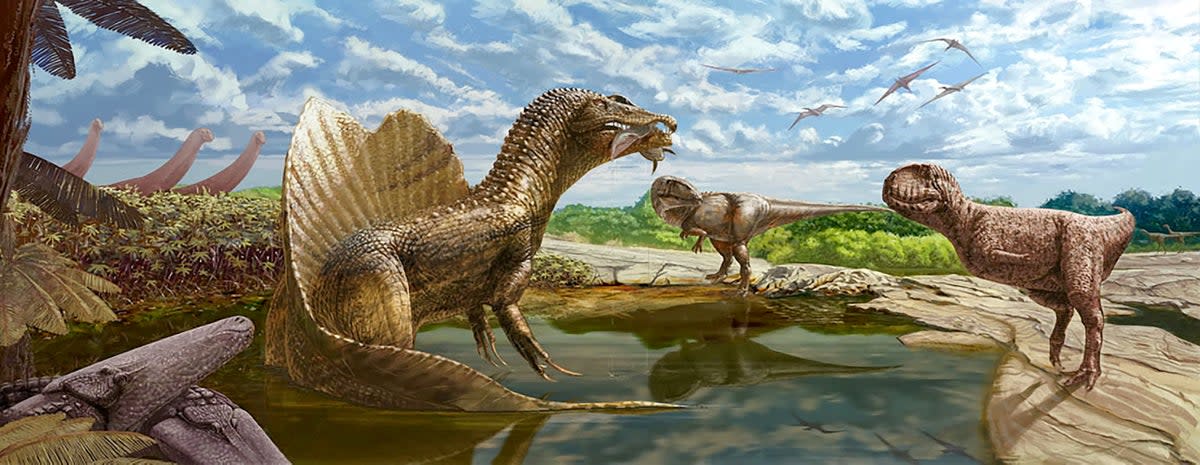Top predator: Head-crested dinosaur with huge ‘sail’ on its back dug up in Egypt is T Rex relative

A spectacular head-crested dinosaur with a huge ‘sail’ on its back has been dug up in Egypt.
The terrifying carnivore was 20 feet long and weighed three tons - as big as a school bus.
It was the top predator in its area. The beast’s 95 million year old fossilised remains were unearthed at the Bahariya Oasis - 180 miles south west of Cairo.
A fearsome killer, it had an extremely powerful bite and very sharp teeth - along with huge claws and a keen sense of smell.
It was a member of the abelisaurids. They were fast moving, bidepal theropods with short, stubby arms - just like their relative T Rex.
The unnamed creature even hunted Spinosaurus - famous for besting a T Rex in Jurassic Park III.
It lived by a river which flowed through the Sahara - lined by mangrove like trees.
Its most striking feature was the spinal sail - formed by elongated vertebrae connected by a membrane.
A series of flat bones beneath the skin reached 6 ft in length. They were covered by a network of fine veins. Blood pumped through them - flushing the sail with colour.
It might have changed hue to attract a mate, frighten an enemy and control body temperature by absorbing heat.
Lead author Belal Salem, a student at Benha University, Egypt, said: “It is the oldest definitive record of the clade from Egypt and northeastern Africa more generally.”
The new species was identified from a large neck vertebra that shares similarities with with other abelisaurids from Madagascar and South America.
They belonged to a family of apex predators that roamed the lands that are now South America, India and Africa.
Scientists think they preyed on some of the largest dinosaurs including titanosaur - a 70-ton herbivore larger than a blue whale.
The discovery also shows the Trans-Saharan Seaway, a warm and shallow ocean that once covered the Sahara Desert, did not prevent their migration.
Mr Salem said: “The new dinosaur attests to a wide geographic distribution of abelisaurids across North Africa, and the extraordinary diversity of large-bodied dinosaurs from Egypt.
“This assemblage of dinosaurs appears to have extended across most or all of northern Africa during the Late Cretaceous.
“It suggests the Trans-Saharan Seaway did not represent a significant barrier to large-bodied theropod dispersal at this time.”
Multiple non-avian theropod dinosaurs have been reported from the Bahariya Formation.
They include Spinosaurus aegyptiacus, Carcharodontosaurus saharicus, Bahariasaurus ingens and Deltadromeus agilis.
Mr Salem added: “Intriguingly, several of these forms - namely Spinosaurus, Carcharodontosaurus, Bahariasaurus and Deltadromeus - attained exceptionally large body sizes - comparable to that of Tyrannosaurus rex.
“Though it undoubtedly pertains to a substantially smaller-bodied animal, the new abelisaurid confirms the presence of a fourth medium-sized to large theropod taxon in the Bahariya Formation paleoecosystem.”
The animal, described in the Royal Society journal Open Science, also shared its environment with pterosaurs, the largest animals that ever flew.

